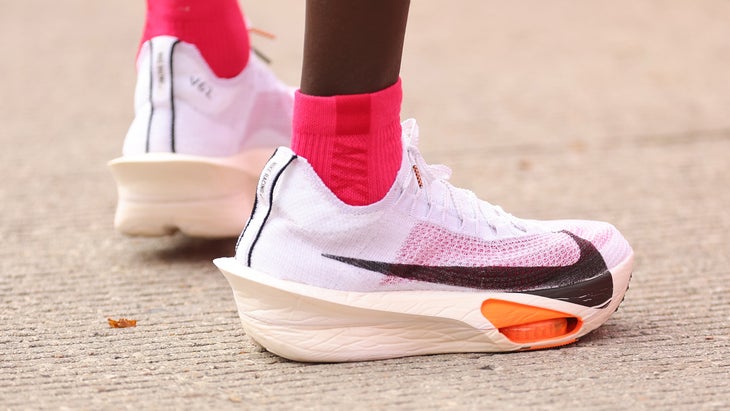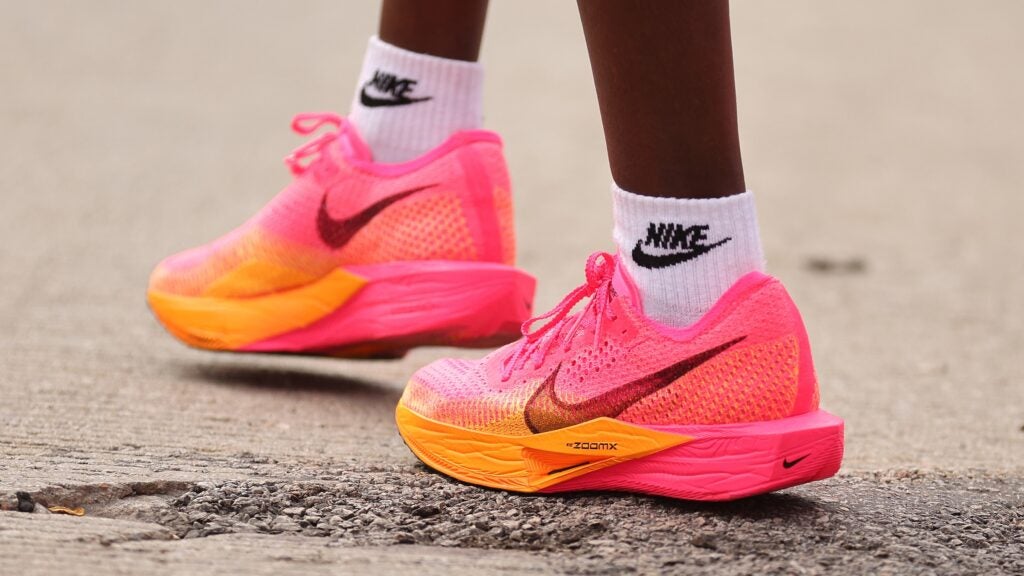No products in the cart.
Outdoor Adventure
What Does It Mean to Be a Super Shoe “Hyper Responder?”
After watching Tigst Assefa’s and Kelvin Kiptum‘s mind-blowing, world record-setting performances in Berlin and Chicago, you might think of them as superhuman. Or you might wonder if their shoes, the brand-new Adidas Adizero Adios Pro Evo 1 and the upcoming Nike Air Zoom Alphafly NEXT% 3, are to thank for huge margins these athletes ran over the previous world record holders—and whether that advanced footwear technology would benefit you in your next marathon.
The truth is, while Assefa and Kiptum won the genetic lottery when it comes to optimizing endurance performance, they likely also respond super well to super shoes. However, not everyone responds in the same way to shoe technology, and not all brands and models provide the same performance boosts. Before you shell out $250 to $500 on a shoe that promises to make you faster, it’s important to consider whether it’s actually the right option for you.
How Do Super Shoes Affect Your Performance?
Before you can question how a super shoe might impact your performance, you have to understand how they work. First, “a super shoe is going to have new foam that’s more compliant and resilient, or springier, and it’s going to have a rigid moderator, like a carbon plate,” explains Dustin Joubert, Ph.D., a kinesiology professor at St. Edward’s University in Austin, Texas.
If a shoe meets those parameters, there are three ways in which it can affect performance, says Jamie Langley, a lecturer in exercise physiology at Loughborough College in the UK. First, they reduce the energetic cost of running, which allows athletes to sustain a higher running velocity; they also enhance critical speed (i.e. your maximum sustainable steady state) during heavy exercise; they also provide enhanced durability through preservation of running economy when the muscles are in a damaged state, meaning those last few miles of that marathon might not feel as difficult.
RELATED: The Supershoe Revolution Continues. Here’s What the Latest Research Says.
The main benefit is in running economy, though. “If you improve economy, you reduce the oxygen cost and the energy cost to run at a given speed,” says Joubert. “In turn, you should be able to run faster at the same physiological intensity.”
That does translate to improved speed—but it’s not a one-to-one translation. “A general estimate would be that you get about two-thirds of the economic benefit translated to velocity improvements,” says Langley. “So if you were 3 percent more economical, you’d be 2 percent faster.”
Not All Super Shoes Are Created Equal, and Not All Runners Respond the Same
The OG super shoe, the Nike Vaporfly 4%, was shown to improve running economy (at paces between 5:22 and 6:54 per mile) by an average of 4 percent, a 2017 study published in Sports Medicine determined. But individual results ranged from 1.59 to 6.26 percent.
With the publication of more research on super shoes—including a 2023 study published in Sports Medicine done on Adidas footwear that claimed performance changes vary from a 10 percent drawback to a 14 percent improvement—the idea that people could range from “non-responders” to “hyper responders” emerged.
A non-responder would be someone who sees no benefit from super shoes or has their running economy negatively affected by wearing them. A low responder would be someone who sees a 2 percent or less boost in advanced footwear, and a super or hyper responder would be someone who experiences a 6 or 7 percent increase in running economy, says Langley. “Assefa and Kiptum may be in the percentage of outliers who experience a higher performance benefit from super shoes, however, without testing them we can’t definitively know.”
OK, let’s not get too wild here. “The term hyper responder has gotten blown out of proportion,” says Joubert. The Adidas study, for example, had a number of variables that “may have blown out the range of individual responsiveness more than really there.” The range of about 1 percent to 7 percent found in the original Nike study is consistent, says Joubert. “In our research, we’ve found about a five percent swing, not a 20-plus percent swing.”
What shoe brand and model you wear will affect the increase in running economy, too. Compared to the ASICS Hyperspeed, which was used as a control shoe, the Hoka Rocket X increased running economy at a 6:00 mile pace by 0.08 percent, the Brookes Hyperion Elite 2 by 0.53 percent, New Balance Fuel Cell RC Elite by 1.37 percent, the Saucony Endorphin Pro by 1.48 percent, the Asics Metaspeed Sky by 2.52 percent, the Nike Zoom X Vaporfly Next % by 2.72 percent, and the Nike Air Zoom Alphafly Next % by 3.03 percent, according to a 2022 study from Joubert, published in Footwear Science.

People running at slower paces will see less of a benefit, Joubert’s more recent research, published in 2023 in The International Journal of Sports Physiology and Performance found. Those running at an 8:03 mile pace saw a 1.6 percent boost in running economy, while 9:40 milers saw just a 0.9 percent increase, on average—and, as a result, they’re likely to see less of an improvement in speed, says Langley. (Unfortunately, researchers don’t really know why yet, although Joubert hypothesizes that at slower speeds, runners aren’t loading the foam or flexing the stiff plate as much as at faster speeds.) “And one thing that stood out is that people who are less economical to begin with had bigger improvements in economy,” says Joubert.
The negative effects on running economy at a certain pace, at least, seem limited. “If you look at the well-controlled studies on the Vaporfly, pretty much everyone gets a benefit,” says Joubert. “It might be 1 percent versus 7 percent, but that’s not negative.” He found more negative responders at the 8:03 and 9:40 paces—but still less than 20 percent of the participants.
How Can You Tell Whether You’ll Respond to Super Shoes?
Super shoes have taken over the running world, but their ubiquity doesn’t guarantee a performance boost. Unfortunately, “there’s not any real research that addresses that question of what makes someone a high or low responder yet,” says Joubert. It’s up to you to figure out whether advanced footwear boosts your performance or not.
Without going into a lab, one of the easiest ways to gauge how a super shoe may affect your performance is through your rate of perceived exertion, on a scale of 1 to 10. “If you’re humming along at marathon pace and things feel easier, you feel like your effort is reduced, that’s a good sign the shoe is going to be useful for you,” says Joubert.
RELATED: Supershoe Showdown: The Best Racers Head-to-Head
You can also look at heart rate. It’s not a perfect metric, but if you hop on a treadmill in one pair of shoes for 10 minutes at marathon pace and record your average heart rate, then rest and do the exact same thing in a second pair of shoes, “that can be a practical way of determining which shoe helps you better utilize oxygen,” says Langley.
At the end of the day, though, it doesn’t matter what physiological benefit a shoe provides if it’s not comfortable or if you feel awkward running in it (a lot of super shoes have strange geometry that takes some time to get used to). Increased footwear comfort is also associated with improved running economy, a 2023 systematic review and meta-analysis published in the European Journal of Sport Science found. Whether it’s a super shoe or not, says Langley, “if it feels comfortable for you, that’s probably going to be the best shoe for you.”

